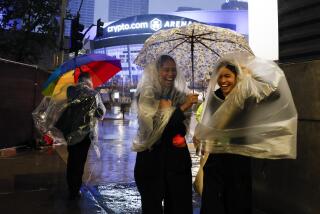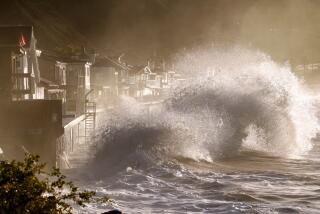Causes of State’s Drought Are as Elusive as Rainfall : Climate: Some scientists believe that no single event triggered each of the five years of the dry spell.
Scientists are looking to ocean currents and temperatures, wind patterns and even volcanic eruptions to explain the causes of California’s prolonged drought, but the answers remain elusive.
Theories that neatly accounted for the lack of rainfall in one year have failed to explain it in the next.
Some scientists believe that no single event triggered each of the five years of drought, saying that warm sea temperatures may have been to blame one year and that strong westerly winds from the central Pacific Ocean may be to blame in another. “I don’t know of a simple, single causal mechanism that explains this,” said Daniel Cayan, climate researcher at Scripps Institution of Oceanography in La Jolla.
Tree ring records suggest that the drought is simply a part of California’s normal climate. What is not normal is decade after decade of heavy rainfall.
Although prolonged droughts were relatively rare in past centuries, shorter and more severe dry spells of one to two years were common, the records show.
Unfortunately, decisions about water use and distribution were made during a time span--1850 to 1950--that stands out as having the fewest short-term, severe droughts in nearly 2,100 years, according to tree ring records from Central California.
“So when everything was being divided up, when contracts were arrived at between states to carve up the Colorado River, we had a falsely optimistic idea of how often these particularly severe short droughts occurred on average,” said Malcolm Hughes, director of tree ring research at the University of Arizona in Tucson.
Experts do not rule out the possibility of a sixth dry winter next year; California’s droughts have stretched that long in the past. But some experts suggest that there could be reasons for optimism.
The most easily identified culprit in the drought has been the jet stream, a narrow band of strong winds in the upper atmosphere that guides storms.
In some years, a strong ridge of high pressure over the West Coast deflected the jet stream away from California and sent storms northward to British Columbia and Alaska.
During most of the drought, including this year, the jet stream has split over the Pacific Ocean. One part of the jet stream swept the moisture and energy away from California to the north, bringing abnormally heavy snowfall to central Alaska. The other drove the storms southeast into Baja California, Mexico, causing flooding in Sonora, Mexico.
Scientists are not sure why either weather pattern occurred, although they offer a variety of theories.
Tim Barnett, a Scripps oceanographer, said an abrupt and mysterious change in the Pacific Ocean’s water temperatures and plant and animal life occurred in the mid-1970s and could indicate that “we might just happen to be in another climate state.”
He said this new state appears to share characteristics with El Nino, a recurring warming event in the equatorial Pacific that has been associated at various times with drought and heavy rainfall in California.
The atmosphere, however, is not responding as it normally does during an El Nino, he said.
Most scientists believe that rainfall typically is heaviest over the warmest waters in the ocean, and that rain provides heat for the atmosphere. Normally, the heaviest rainfall is found over Indonesia, but during El Nino events, it shifts to the International Date Line in the central Pacific.
Now, however, “the warm water is shifting but precipitation in the atmosphere is not shifting, at least not yet,” Barnett said.
Barnett refuses to speculate on why the changes in the ocean may be occurring.
“We sort of understand climate variations on the scale of the Ice Age and have some idea of how they may work on the seasonal scale,” he said, “but in the range of climate change in a couple of years to a century, we don’t have a clue.”
Art Douglas, a meteorologist and long-range forecaster at Creighton University in Omaha, believes that there is too little evidence to indicate the emergence of a new climate state, which could change weather for decades.
Instead, he sees each of the five dry-weather years as largely independent of one another. Both El Ninos and “anti-El Ninos”--cold water in the equatorial Pacific--have occurred during the past five years without any noticeable impact on the drought, he said.
Douglas does find reasons to hope for an end to the drought next year.
He noted that three previous droughts, including the ruinous Dust Bowl years of the 1930s, have been followed by El Ninos that brought rain and snow to California. The same, he said, could happen next year.
The National Weather Service had expected an El Nino this year, and many believed it would bring wet weather to California. But Douglas said he predicted more drought because of a warm-water pool in the north Pacific that he believed to be inconsistent with an El Nino.
“An El Nino has never occurred when that pool was present,” he said. And so far this year, an El Nino has not developed.
But winds are pushing that warm north Pacific water eastward, setting up conditions for an El Nino that could bring wet weather next year, according to Douglas. Similar circumstances existed just before El Ninos delivered much-needed rainfall after the three most recent droughts.
“I pretty much expect that there is going to be an El Nino in 1991-92, and if California is lucky, maybe we will follow out those three periods and end up with a wet winter,” he said.
Other climate experts say a sixth year of drought would be improbable, but they caution that it is too early to predict an El Nino or wet weather for next year.
“I hope (Douglas) is right,” Scripps’ Cayan said, “but I think there is still uncertainty as far as El Nino next year, and even if we do get it, it is not a sure-fire predictor for California precipitation.”
Global warming, like ocean temperatures, also has been theoretically linked to drought. But scientists say that the current dry spell cannot be blamed on the greenhouse effect, the buildup of gases in the atmosphere that trap heat on Earth.
Although some global warming models predict that droughts will grow in frequency and intensity in the 1990s, most scientists say there is no convincing evidence that dry spells are increasing.
“You can’t blame a specific drought on the greenhouse effect because droughts are a natural phenomenon,” said climatologist James Hansen, director of the Goddard Institute for Space Studies in New York.
Another possible explanation is put forward by Prof. Paul Handler, a physicist at the University of Illinois in Champaign-Urbana. He traces the dry spell in the West to the absence of volcanic eruptions near the Equator.
Strong eruptions alter the climate by producing stratospheric dust and sulfur dioxide gas that block some sunlight from reaching the Earth’s surface, he said.
Although Handler has successfully predicted each year of California’s drought, his theory is considered controversial.
“I guess I am worried that we haven’t had a long enough record of volcanic eruptions, along with extreme weather, to say with any certainty that there is any causal relationship,” Cayan said.
Other scientists speculate that solar cycles or sunspots may be related to drought by increasing the cosmic rays reaching the Earth, a theory that is not backed up by tree ring data from California, said David Meko, associate staff scientist at the University of Arizona’s tree ring lab.
Tree ring records are valuable because they show what California and the West might expect in the future when it comes to drought by revealing the past. Some experts caution that tree rings may not always show the first year of a drought. The rings also tend to reflect regional conditions. In general, the more narrow the ring in a tree sensitive to rainfall, the drier the year.
Northern California tree rings dating to 1600 show evidence of a six-year drought in the 1840s and another prolonged dry spell in the 1920s and 1930s, according to Meko.
Meteorologist Douglas said tree records from the Santa Ana Mountains in Southern California indicate a six-year drought in the 1700s. The records also show there have been four three-year droughts since 1700: in the 1750s, the 1890s, from 1959 to 1961, and in the early 1970s.
For 55 years, from 1690 to 1745, there was not a single winter with heavy rainfalls in Santa Barbara County, according to tree ring records cited by climatologist Joel Michaelsen, a professor at UC Santa Barbara. He said the same pattern was repeated throughout much of Southern California in that period.
“While most of the years were not particularly dry, if such an event were to happen now, we would eventually have severe water shortages because there would be a gradual drawdown of the reservoirs,” Michaelsen said. In contrast, the current emptying of reservoirs is due more to actual drought conditions.
Severe short-term droughts, such as the 1976-77 episode, have been more common than prolonged dry spells, according to tree rings from Central California. California, according to the records, tends to have an average of 4 1/2 short but extreme droughts every century.
“We find very clear evidence that even drought as severe as the one we are in is just a natural part of the climate variability,” Michaelsen said.
Fortunately, he said, droughts usually do not occur at the same time in California and in the Colorado River Basin (the source of much of Southern California’s water), so reservoirs tend to have sufficient supplies for most dry spells. During much of the current drought, California and the basin have been dry, exacerbating the problem.
California’s rainy season typically does not end until April and heavy storms still could smash into the state and spare many communities stringent rationing. There was an unexpected and extraordinary deluge in Central California in February and March of 1986, after what had been a dry winter.
Meteorologists and other experts familiar with California’s situation say there is only a 5% to 10% chance of that happening this time.
“It would take an enormous amount of rain,” California hydrologist Maurice Roos said.
More to Read
Sign up for Essential California
The most important California stories and recommendations in your inbox every morning.
You may occasionally receive promotional content from the Los Angeles Times.











